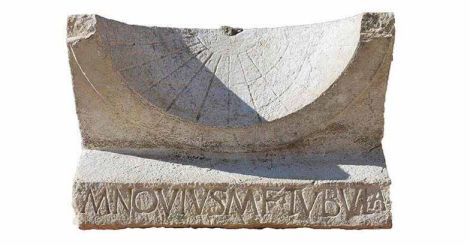London: 2,000-year-old intact and inscribed Roman sundial - one of only a handful known to have survived - has been discovered during the excavation of a roofed theatre in Italy, Cambridge scientists said on Thursday.
Not only has the sundial survived largely undamaged for more than two millennia, but the presence of two Latin texts allowed the researchers to glean precise information about the man who commissioned it.
The sundial was found in the Roman town of Interamna Lirenas, lying face down by researchers from the University of Cambridge in the UK as they were excavating the front of one of the theatre's entrances along a secondary street.
It was probably left behind at a time when the theater and town was being scavenged for building materials during the Medieval to post-Medieval period.
In all likelihood it did not belong to the theater, but was removed from a prominent spot, possibly on top of a pillar in the nearby forum, researchers said.
"Less than a hundred examples of this specific type of sundial have survived and of those, only a handful bear any kind of inscription at all - so this really is a special find," said Alessandro Launaro, a lecturer at Cambridge.
"Not only have we been able to identify the individual who commissioned the sundial, we have also been able to determine the specific public office he held in relation to the likely date of the inscription," said Launaro.
Carved out from a limestone block, the sundial features a concave face, engraved with 11 hour lines intersecting three day curves.
Although the iron gnomon (the needle casting the shadow) is essentially lost, part of it is still preserved under the surviving lead fixing.
This type of 'spherical' sundial was relatively common in the Roman period and was known as hemicyclium, researchers said.
"The base prominently features the name of M(arcus) NOVIUS M(arci) F(ilius) TUBULA [Marcus Novius Tubula, son of Marcus], whilst the engraving on the curved rim of the dial surface records that he held the office of TR(ibunus) PL (ebis) (Plebeian Tribune) and paid for the sundial D(e) S(ua) PEC(unia) (with his own money)," they said.
Various considerations about the name of the individual and the lettering style comfortably place the sundial's inscription at a time (mid 1st BC onwards) by which the inhabitants of Interamna had already been granted full Roman citizenship, researchers said.
"That being the case, Marcus Novius Tubula, hailing from Interamna Lirenas, would be a hitherto unknown Plebeian Tribune of Rome.
"The sundial would have represented his way of celebrating his election in his own hometown," added Launaro.
Read more: World | Uber in deal with NASA to develop flying taxis

























 Carved out from a limestone block, the sundial features a concave face, engraved with 11 hour lines intersecting three day curves | Photo: University of Cambridge
Carved out from a limestone block, the sundial features a concave face, engraved with 11 hour lines intersecting three day curves | Photo: University of Cambridge